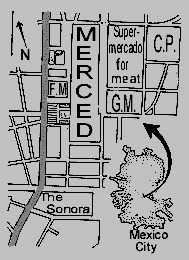 The
map at the right shows that the huge mercado in which our "one day" takes place
is actually a complex of market buildings. The main building, the Merced,
is the main destination of most shoppers. A subway entrance opens in the main Merced
building's center.
The
map at the right shows that the huge mercado in which our "one day" takes place
is actually a complex of market buildings. The main building, the Merced,
is the main destination of most shoppers. A subway entrance opens in the main Merced
building's center.
In the map, the north-south-running grayed-in street is the essay's much mentioned, very busy Anillo de Circunvalación. The small building marked "F.M." is the Flower Market, one colorful entrance to which is shown below. The "GM" is the General Market, basically a smaller, even more congested version of the Merced; it's where I bought my granola. The Supermercado for meat consists of untold numbers of butchershops, plus my "comedor with a boquet." The "C.P." is the new, upscale Commercial Plaza, mostly empty, and not nearly as colorful as the rest of the area.
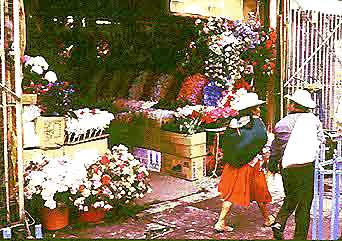 At the left you see
one entrance to the Flower Market. You can bet that anyone passing by
that door walks through a moist bouquet of aromas that almost knock you off your feet. The
colors and variety of floral designs are as overwhelming as the odors. Next to the flower
market stands the Iglesia de Santo Tomás de la Palma , a dignified, scrupulously clean
little church with a spacious courtyard paved in stone, completely enclosed by a high
stone fence. When services there require flowers, the Flower Market could not be more
convenient.
At the left you see
one entrance to the Flower Market. You can bet that anyone passing by
that door walks through a moist bouquet of aromas that almost knock you off your feet. The
colors and variety of floral designs are as overwhelming as the odors. Next to the flower
market stands the Iglesia de Santo Tomás de la Palma , a dignified, scrupulously clean
little church with a spacious courtyard paved in stone, completely enclosed by a high
stone fence. When services there require flowers, the Flower Market could not be more
convenient.
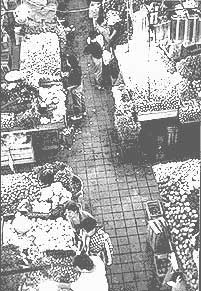 The Merced's
interior consists of aisle after aisle -- some fifteen of them -- of unwalled, room-size
establishments arranged next to one another. The picture shows the corners of four of the
Merced's hundreds, each of these specializing in oranges, but sometimes making room for a
few other fruits. Other sections of the mercado specialize in different produce. Walk
through the fresh pepper zone and your eyes water; walk through the garlic area and your
head swims.
The Merced's
interior consists of aisle after aisle -- some fifteen of them -- of unwalled, room-size
establishments arranged next to one another. The picture shows the corners of four of the
Merced's hundreds, each of these specializing in oranges, but sometimes making room for a
few other fruits. Other sections of the mercado specialize in different produce. Walk
through the fresh pepper zone and your eyes water; walk through the garlic area and your
head swims.
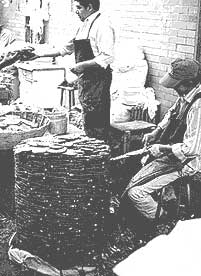 Yet another zone in the Merced deals with
almost nothing but cactus pads, which are being marketed in the picture at the right. In
this photo you can see thousands of cactus pads arranged in a cylindrical mass, the white
shipping canvas lying at the cylinder's base. In Mexico's arid uplands sometimes you see
whole fields of a special, mostly thornless cactus, called nopal, being grown for
food.
Yet another zone in the Merced deals with
almost nothing but cactus pads, which are being marketed in the picture at the right. In
this photo you can see thousands of cactus pads arranged in a cylindrical mass, the white
shipping canvas lying at the cylinder's base. In Mexico's arid uplands sometimes you see
whole fields of a special, mostly thornless cactus, called nopal, being grown for
food.
In the picture the merchant conducts a sale while his young helper does exactly what he does the whole day, day after day -- sit paring away imperfections and the occasional spine from one cactus pad after another. In Mexican cuisine, cactus pads are often sliced into slivers, then fried with onion and other ingredients, and doused in lemon juice. The slices are referred to as nopalitos.
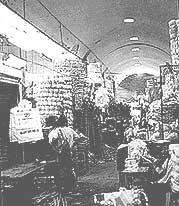 The picture
to the left shows an interior view of the Merced, with one of its several long, vaulting
ceilings towering overhead. The white, cylindrical stacks in the photo consist of clean,
dry cornshucks, mostly destined to serve as organic, thoroughly traditional wrappers for
steamed tamales. A whole section of the Merced is dedicated to cornshucks, and one can
hardly imagine that such a demand exists for them. Not far away a similar section sells
only neatly cut and wrapped cuttings of banana leaves, which are also used for wrapping
steamed tamales.
The picture
to the left shows an interior view of the Merced, with one of its several long, vaulting
ceilings towering overhead. The white, cylindrical stacks in the photo consist of clean,
dry cornshucks, mostly destined to serve as organic, thoroughly traditional wrappers for
steamed tamales. A whole section of the Merced is dedicated to cornshucks, and one can
hardly imagine that such a demand exists for them. Not far away a similar section sells
only neatly cut and wrapped cuttings of banana leaves, which are also used for wrapping
steamed tamales.
 Mercado dealings
usually overflow into streets adjoining and just beyond the main mercdo area. In the
picture at the right, a block from the Merced, an Indian family has set up business
selling white plastic bags of charcoal. Charcoal fires the many thousands of streetside comales
roasting tacos, huaraches, ears of corn,and many other foods. Many homes and restuarants
also use it. Of course, the charcoal business clears the land of its trees, but what is
there better to take charcoal's place?
Mercado dealings
usually overflow into streets adjoining and just beyond the main mercdo area. In the
picture at the right, a block from the Merced, an Indian family has set up business
selling white plastic bags of charcoal. Charcoal fires the many thousands of streetside comales
roasting tacos, huaraches, ears of corn,and many other foods. Many homes and restuarants
also use it. Of course, the charcoal business clears the land of its trees, but what is
there better to take charcoal's place?